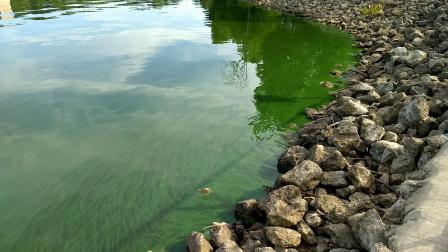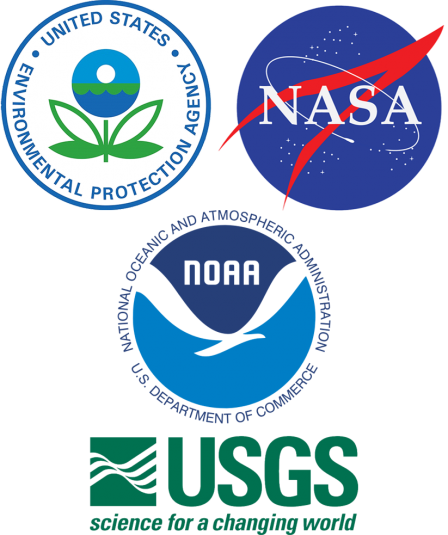Cyanobacteria Assessment Network Mobile Application (CyAN app)
Make faster decisions related to cyanobacterial algal blooms
On this Page
EPA's Cyanobacteria Assessment Network mobile application (CyAN app) is an easy-to-use and customizable app that provides access to algal bloom satellite data for over 2,000 of the largest lakes and reservoirs across the United States. EPA scientists developed the CyAN app to help local and state water quality managers make faster and better-informed management decisions related to cyanobacterial blooms.
Compatibility and Availability
 The CyAN app is free and available for download on Google Play™. It is designed for use on Android™ devices and is compatible with versions 4.2-9.0 (API levels 18-26).
The CyAN app is free and available for download on Google Play™. It is designed for use on Android™ devices and is compatible with versions 4.2-9.0 (API levels 18-26).
The CyAN app is currently being developed as a web-based app, which will be compatible with most devices.
Disclaimer: Any mention of trade names, products, services, or enterprises does not imply an endorsement by the U.S. Government or EPA. Google Play and the Google Play logo are trademarks of Google LLC.
Capabilities and Applications
Capabilities
The CyAN app provides an easy to use, customizable interface to scan water bodies for changes in cyanobacteria occurrence without requiring computer programming expertise.
It is designed to inform decisions regarding recreational and drinking water safety by providing water quality managers with a user-friendly platform that reduces the complexities associated with accessing satellite data to allow fast and efficient initial assessments across water bodies that are roughly one square kilometer or greater. The primary satellite sensor collecting data is the European Space Agency’s Copernicus Sentinel-3 Ocean and Land Colour Instrument.Exit
Users can view information about cyanobacteria concentrations on a national-scale or can zoom in to single-out data for a lake or reservoir. Because states and localities may address harmful algal blooms differently, users can determine their own thresholds for cyanobacteria concentrations. Users can also compare multiple water bodies at once, allowing for better-informed decisions based on recent changes at specific locations.
 Applications
Applications
Because the CyAN app uses satellite data to map the location of cyanobacterial blooms in fresh and coastal waters across the United States, it can be used to quickly inform decisions regarding recreational and drinking water safety.
Lake managers, for example, could use the CyAN app on a weekly basis to monitor lakes in their region. At a quick glance of their mobile devices, they could pinpoint potential problem areas and focus their attention and resources there. The data might prompt them to manually collect water samples from certain lakes for more information or issue a public advisory that closes local shores to recreation.
The CyAN app is an experimental mobile application and provides provisional satellite derived measures of cyanobacteria, which may contain errors and should be considered a research level tool.
Research Collaboration
Most species of algae are not harmful, but sometimes certain types bloom in excessive amounts and can cause harm to human and pet health, aquatic ecosystems, and local economies. Referred to as harmful algal blooms (HABs), they are usually associated with algae that produce toxins and can cause environmental problems across the Nation.
Even though they are classified as bacteria, cyanobacteria—sometimes referred to as blue-green algae—exhibit characteristics of algae and are associated with HABs. Cyanobacterial HABs, which can appear in water bodies across the country, are an indicator of poor water quality and can potentially cause serious environmental concerns, including human and aquatic health effects. When blooms occur in recreational waters or source waters used for drinking, the toxins that may be released can cause respiratory or skin irritation and even illness in humans, domestic animals, and wildlife.
 Historically, monitoring cyanobacteria blooms has been labor intensive and limited due to cost, time, and logistical constraints. EPA researchers are looking for ways to eliminate or reduce the negative effects of HABs on human health and the environment. Their efforts include the development of the CyAN app. The research that led to the development of the app was conducted in collaboration with the National Aeronautics and Space Administration (NASA), the National Oceanic and Atmospheric Administration (NOAA), and the U.S. Geological Survey (USGS). It was tested for over one year and the functionality and satellite data were successfully validated with 25 state health advisories issued in 2017.
Historically, monitoring cyanobacteria blooms has been labor intensive and limited due to cost, time, and logistical constraints. EPA researchers are looking for ways to eliminate or reduce the negative effects of HABs on human health and the environment. Their efforts include the development of the CyAN app. The research that led to the development of the app was conducted in collaboration with the National Aeronautics and Space Administration (NASA), the National Oceanic and Atmospheric Administration (NOAA), and the U.S. Geological Survey (USGS). It was tested for over one year and the functionality and satellite data were successfully validated with 25 state health advisories issued in 2017.
To provide data for the app, EPA is continuing research and collaboration efforts with NASA, NOAA, and USGS through the CyAN Project.
Resources
CyAN App Resources:
- User's Guide
- Fact Sheet
- Palm Card
- Journal ArticleExit (Mobile App for Monitoring Cyanobacteria HABs using Sentinel-3 Satellite Ocean and Land Colour Instruments)
- List of Resolvable Lakes (.docx)Exit (supplemental material from journal article above)
- Science Matters Article (CyAN Mobile App Helps Communities Detect Cyanobacteria in U.S. Water Bodies)
Related Resources:
Training and Support
- Training VideoExit
- Highlight VideoExit
- Questions or comments: Contact us at the CyAN Project

